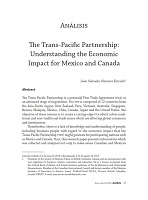The Trans-Pacific Partnership: Understanding the Economic Impact for Mexico and Canada
DOI:
https://doi.org/10.32870/mycp.v5i13.498Keywords:
Trans-Pacific Partnership, free trade agreement, North America, trade and investment, international economics.Abstract
The Trans-Pacific Partnership is a potential Free Trade Agreement (FTA) at an advanced stage of negotiation. The TPP is composed of 12 countries from the Asia-Pacific region: New Zealand, Peru, Vietnam, Australia, Singapore, Brunei, Malaysia, Mexico, Chile, Canada, Japan and the United States. The objective of these nations is to create a cutting-edge fta which solves tradi- tional and non-traditional trade issues which are affecting global commerce and investments. Nonetheless, there is a lack of knowledge and understanding of people, including business people with regard to the economic impact that the Trans-Pacific Partnership (TPP) might generate for participating nations such as Mexico and Canada. Thus, this research paper presents information which was collected and analyzed not only to make aware Canadian and Mexican business people about the relevance of the tpp, but also to encourage them to find synergies and collaborations between them. Analysis was based on secondary research, collecting information through multiple secondary data sources to provide different perspectives.The research drew attention to the fact that the tpp region might become one of the most relevant trade regions around the globe, because it would represent an attractive market of more than 800 million consumers, representing about 40% of the Global GDP (Dawson & Bartucci, 2013: 2-4). Further investigations revealed that the economic impact of the tpp for all 12 nations would be positive and based on trade creation. It is estimated that by 2025, the TPP would produce extra income in the world trade of 295 billion USD (Petri, Plummer & Zhai, 2012: 85). In the particular case of Canada and Mexico, economists have pointed out that by 2025, Mexico could receive sub- stantial benefits from the tpp, gaining 21 billion usd in additional income, whereas Canada would also gain extra income, about 9.9 billion usd (Petri et al., 2012: 40-44). Finally, this research paper states five recommendations for Canadian and Mexican business people to increa se their knowledge and understanding of the tpp and they contribute to get the benefits when this FTA is in force.Downloads

Published
How to Cite
Issue
Section
License
Open Access Policy
This journal provides open access to all its contents, in adherence to the principle that making research freely available supports a greater global exchange of knowledge.
MyCP is licensed under a Creative Commons Attribution-NonCommercial license, also known as CC BY-NC.
Contents are published in both PDF and XML formats.
Authors who publish in México y la Cuenca del Pacífico must accept the following conditions:
Pursuant to Mexican copyright laws, México y la Cuenca del Pacífico acknowledges and respects the authors’ moral right and ownership of property rights, which will be assigned to the University of Guadalajara to publish the articles in an open-access mode.
México y la Cuenca del Pacífico does not charge the authors any fees for receiving and processing their articles.
Authors are permitted to enter into other independent and additional contractual agreements for the non-exclusive distribution of the article version published in México y la Cuenca del Pacífico (for example, publishing it in an institutional repository or in other printed or electronic media) as long as they clearly state that the piece was originally published in México y la Cuenca del Pacífico.
Pursuant to the above, once the article is approved for publication, authors must send the Assignment of Rights Agreement form duly filled and signed. This form must be sent to mexicoylacuenca@gmail.com as a PDF file.
Readers/users of México y la Cuenca del Pacífico can freely access the journal new issues as soon as they are uploaded. Readers/users are allowed to cite, share (both electronically and physically), print and distribute the material, provided they expressly state that the work was originally published in México y la Cuenca del Pacífico. Contents are to be properly cited and never for commercial purposes.




